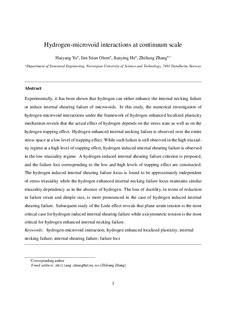| dc.contributor.author | Yu, Haiyang | |
| dc.contributor.author | Olsen, Jim Stian | |
| dc.contributor.author | He, Jianying | |
| dc.contributor.author | Zhang, Zhiliang | |
| dc.date.accessioned | 2019-07-09T06:58:28Z | |
| dc.date.available | 2019-07-09T06:58:28Z | |
| dc.date.created | 2018-04-06T21:02:18Z | |
| dc.date.issued | 2018 | |
| dc.identifier.citation | International journal of hydrogen energy. 2018, 43 (21), 10104-10128. | nb_NO |
| dc.identifier.issn | 0360-3199 | |
| dc.identifier.uri | http://hdl.handle.net/11250/2603809 | |
| dc.description.abstract | Experimentally, it has been shown that hydrogen can either enhance the internal necking failure or induce internal shearing failure of microvoids. In this study, the numerical investigation of hydrogen-microvoid interactions under the framework of hydrogen enhanced localized plasticity mechanism reveals that the actual effect of hydrogen depends on the stress state as well as on the hydrogen trapping effect. Hydrogen enhanced internal necking failure is observed over the entire stress space at a low level of trapping effect. While such failure is still observed in the high triaxiality regime at a high level of trapping effect, hydrogen induced internal shearing failure is observed in the low triaxiality regime. A hydrogen induced internal shearing failure criterion is proposed, and the failure loci corresponding to the low and high levels of trapping effect are constructed. The hydrogen induced internal shearing failure locus is found to be approximately independent of stress triaxiality while the hydrogen enhanced internal necking failure locus maintains similar triaxiality dependency as in the absence of hydrogen. The loss of ductility, in terms of reduction in failure strain and dimple size, is more pronounced in the case of hydrogen induced internal shearing failure. Subsequent study of the Lode effect reveals that plane strain tension is the most critical case for hydrogen induced internal shearing failure while axisymmetric tension is the most critical for hydrogen enhanced internal necking failure. | nb_NO |
| dc.language.iso | eng | nb_NO |
| dc.publisher | Elsevier | nb_NO |
| dc.rights | Attribution-NonCommercial-NoDerivatives 4.0 Internasjonal | * |
| dc.rights.uri | http://creativecommons.org/licenses/by-nc-nd/4.0/deed.no | * |
| dc.title | Hydrogen-microvoid interactions at continuum scale | nb_NO |
| dc.title.alternative | Hydrogen-microvoid interactions at continuum scale | nb_NO |
| dc.type | Journal article | nb_NO |
| dc.type | Peer reviewed | nb_NO |
| dc.description.version | publishedVersion | nb_NO |
| dc.source.pagenumber | 10104-10128 | nb_NO |
| dc.source.volume | 43 | nb_NO |
| dc.source.journal | International journal of hydrogen energy | nb_NO |
| dc.source.issue | 21 | nb_NO |
| dc.identifier.doi | 10.1016/j.ijhydene.2018.04.064 | |
| dc.identifier.cristin | 1578042 | |
| dc.relation.project | Norges forskningsråd: 234130 | nb_NO |
| dc.description.localcode | © 2018. This is the authors’ accepted and refereed manuscript to the article. Locked until 30.4.2020 due to copyright restrictions. This manuscript version is made available under the CC-BY-NC-ND 4.0 license http://creativecommons.org/licenses/by-nc-nd/4.0/ | nb_NO |
| cristin.unitcode | 194,64,45,0 | |
| cristin.unitname | Institutt for konstruksjonsteknikk | |
| cristin.ispublished | true | |
| cristin.fulltext | original | |
| cristin.qualitycode | 2 | |

